It had to happen eventually in our backyard, where so much happens all the time, and so it did—we now have a small population of poison ivy plants. One of them is a beauty, climbing up our twelve-foot dead maple stump and racing a native bittersweet to the top. Others peek out from surrounding vegetation in nooks and crannies of the yard, even along the house foundation or a little terrace made of pavers. Not many, but enough. Maybe too many.
Toxicodendron radicans is trying to work its way into our affections.
Let’s get the dull stuff out of the way first. Poison ivy is a member of the Anacardiaceae, or sumac, family and in fact used to be known as Rhus radicans or R. toxicodendron. It can often be mistaken for harmless sumacs and vice-versa.

This is NOT poison ivy. This is aromatic sumac (Rhus aromatica) and it’s harmless (and smells nice).
Here’s a good description from the Wildflower Center: “Upright, climbing, or trailing shrub that bears small yellowish-white flower clusters; old stems, covered with fibrous roots, look hairy. Poison Ivy is extremely variable in form, occurring as a ground cover along roadsides, an erect shrub (especially in sandy coastal areas), or a large vine on trees. Red fall foliage is especially conspicuous.”
In the fall it forms grapelike clusters of seeds (drupes) that are tan or cream-colored.
Its most cited identifying factor is the alternate arrangement of leaves with their three leaflets, hence “Leaves of three, let it be.” Wise words. Its distribution is all over the eastern and central United States and up into Ontario and to Nova Scotia. It is said to like edges, and that certainly seems true in our yard, where it pokes up around the border of lawn and other vegetation, and along walls and fences.
That said, it’s a shame that we have such an historically antagonistic relationship with this plant, because it’s really not a bad actor in the larger scheme of things.
You may not be shocked to learn that this plants is not particularly well-studied for its ecological benefits. It is known, however, to be used for food and shelter by a good variety of our wildlife, including deer, racoons, muskrats, wild turkeys and many other birds. Horses and goats seem to love it. Plus, it has many insects and bugs associated with it: “Thirty-seven distinct insect floral associates were observed (during the 2005 flowering season in Iowa): 8 coleopterans (beetles), 7 dipterans (flies), 2 hemipterans (true bugs), 19 hymenopterans (ants, bees, wasps), and 1 lepidopteran (butterfly).” It seems to be kind of a pollination generalist, saying “Come and get it!” to a wide variety of potential reproductive helpmeets, which could be one reason for its obvious success in getting around. Pollinators swarm over it, birds and other animals munch down the seeds, then move off and deposit them where, mostly, we don’t want them.
To my eye, this is also a pretty plant, especially since I’m a fan of virginia creeper (Parthenocissus quinquefolia), which is occasionally mistaken for poison ivy.
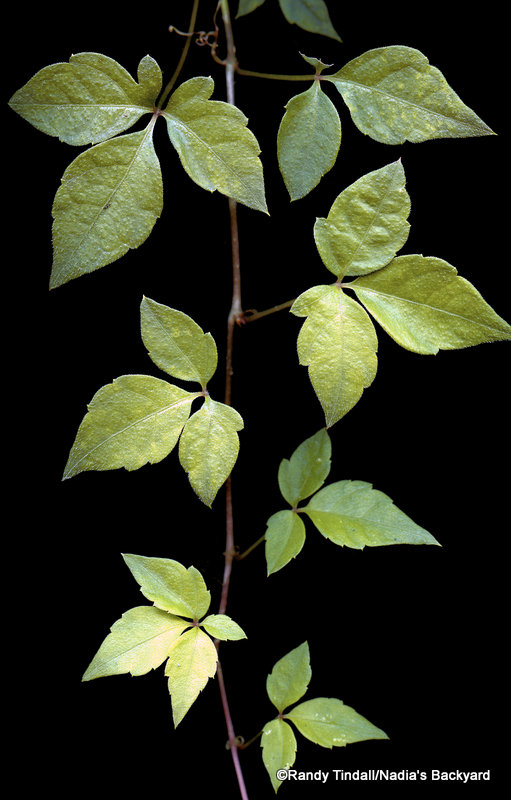
This is NOT poison ivy. This is Virginia creeper (Parthenocissus quinquefolia ). Usually shows five leaflets, instead of three.
It will form long attractive vines to climb trees when they are available or just form small bushy bunches and low-growing vines, if it can’t find anything to grab onto. It was apparently first described by Captain John Smith and samples were later taken back to England and incorporated into English gardens for its pretty appearance as a climber and for its beautiful red autumn foliage. I expect someone eventually got in trouble for that.
It’s not always very conspicuous, which is why a friend of mine once asked me just what poison ivy looked like and, when I pointed out that he was standing right in a large clump of it, beat a hasty retreat. Seemed he had just had a horrendous experience involving string trimmers, short pants and no shirt on a hot, muggy, sweaty day and at least one patch of poison ivy. Use your imagination.
For our trifoliate friend is, of course, most famous for being poisonous to most humans, due to its secretion of a resin containing a compound known as urushiol, which I think is Klingon or something for “sheer misery”. Now I am one of those obnoxious people who has never had a reaction to poison ivy, but (and opinions vary on this) I take the view that if I and those like me get cocky and careless about our “immunity”, we are asking for a painful comeuppance. In other words, I’m very careful around the stuff because I expect that I would develop sensitivity after repeated exposure and I intend to never find out. Nadia, on the other hand, IS sensitive to it and develops the signature red streaks, blisters and intense itching that are all too familiar to fellow sufferers.
Urushiol is an interesting compound, eliciting reactions in most people at vanishingly low levels of concentration. A trip around the internet reveals lots of statements like, “Even the amount on a pinhead is sufficient to cause rashes in 500 sensitive people.” It also seems that we fortunate humans are the only, or one of a very few, species which have painful reactions to it. But it seems as if urushiol itself isn’t the problem, but our own highly developed immune systems, which for some reason go into overdrive in its presence and cause the misery. The enemy is us!
Urushiol apparently penetrates the skin and bonds with certain membranes in certain skin cells and, long story short, causes our immune system to not recognize these cells as being part of our own bodies. It attacks, causing the rash, blisters, itching and pain, in something similar to an auto-immune response. The trick to avoid this is, 1) avoid the plant (here’s a test!), but, 2) if exposed, get the resin off ASAP (within 15 minutes ideally) with cold water, soap and lots of rinsing. (It’s said to be best to not use hot water because that tends to open the pores of the skin, facilitating the penetration of the resin.
As far as the plant is concerned, the resin seems to aid in preventing water loss by forming a hard black lacquer-like coating that seals damage in the stems and leaves. This is why the resin from related species has been used for centuries to make real lacquers (called “urushi” in Japanese—get it?) for furniture and artworks and has been experimented with to make a waterproof ink for such things as marking laundry! (Apparently this caused some consternation to a few allied troops in WW II.) It certainly can’t be adaptive for protection, since so many things eat the plant with great joy. In fact, it’s counterproductive in that regard, since it makes humans, with all their destructive talents, want to obliterate it from the universe.
Ironically, however, it may be that humans are actually the most potent force in causing the spread of this accidental villain and even in making it more potent. Recent studies indicate that increasing CO2 levels may even have doubled its numbers and the potency of its resin, and that they may double again in a few decades.
So. We have this problematic plant in our backyard. Are we keeping it? The jury’s still out on that, but we have started reducing its presence, using long-sleeved shirts and gloves to pull the plants and stuff them into a plastic garbage bag. Eye protection may not be a bad idea, either, especially when pulling vines down off trees, possible causing tearing of the plant and splattering of the resin.
I’m debating leaving the climber on our 12-foot stump, and maybe put a warning sign on it for visitors. Of course, this will mean a source of seed that will cause more plants to appear in our backyard, but we should be able to keep it under control. I mean, it’s native, animals and insects like it, and we can avoid it.
After all, it doesn’t mean to be bad. It just worked out that way.

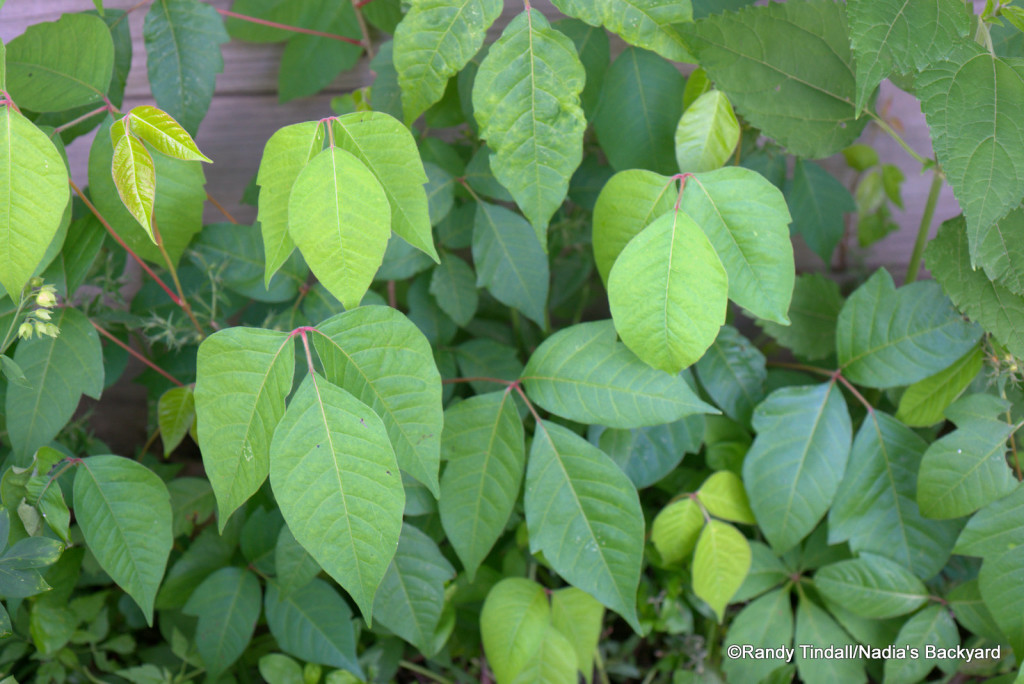
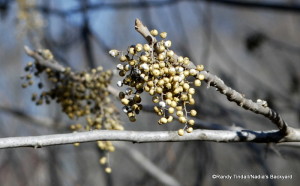
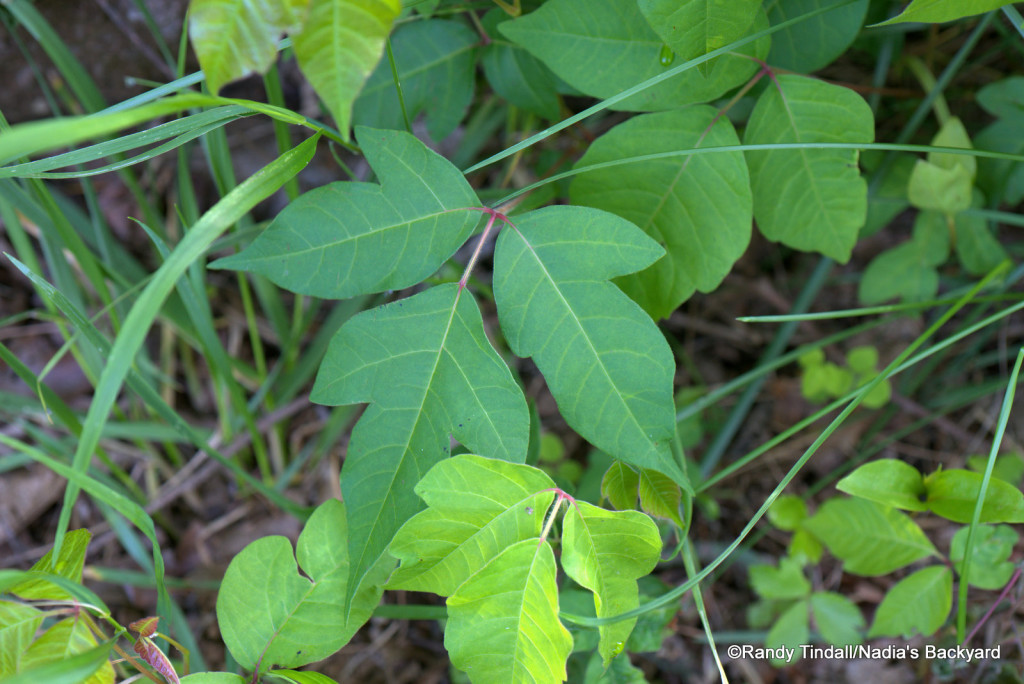
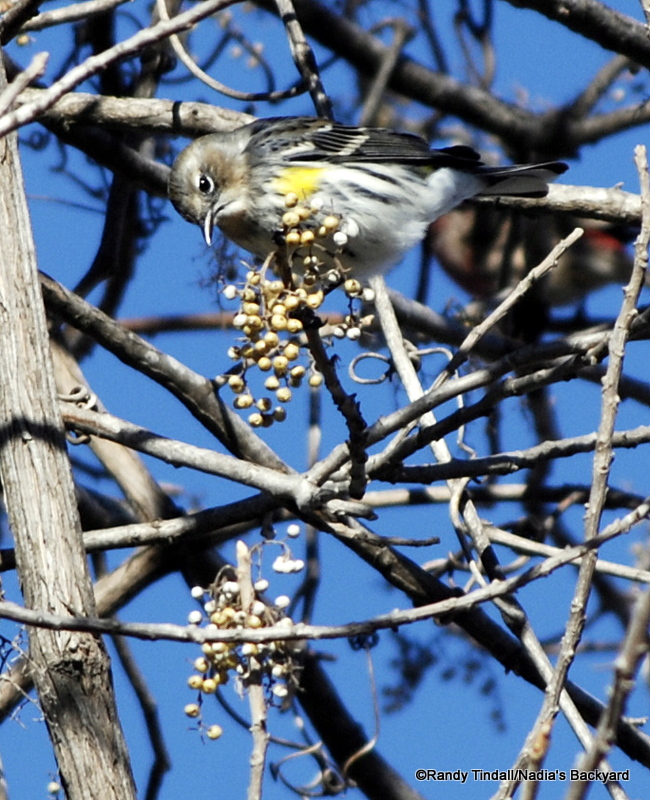

Wonderful article on this much maligned plant. I am very allergic but also a very avid native plant enthusiast, so I have decided to let it go nuts on a piece of property that I own exclusively for planting things. It’s in a low-income neighborhood with a lot of foot traffic, and I think this might help keep people off of my property.
Well, if they trespass and don’t know what they’re getting into, they probably won’t do it again! Thanks for reading.
Randy Thank You so much for the wonderful information on this site. Hats off to you and Nadia.
Many years ago my daughter who is now 27, was horribly allergic to many plants and of course poison Ivy was the worst. If she stood near it the wind would blow it her way.
One summer she and her little friend when they were about 9 made mud pies and tea with poison ivy. They Drank the Tea! My daughter was covered in a rash from scalp to toe. We had to go to the Dr. which was rare for us. she had to be soaked in oatmeal for…it seems a month (it was a long time ago).
I will say after all that, she has never ever broken out from the Ivy since, and has been around it. I Do Not suggest drinking it. But By golly it cured her.
I’m really glad for the happy ending! Some stories of people ingesting poison ivy don’t end up so well, although your daughter obviously suffered a lot. I have never had a reaction to poison ivy myself, but I treat it like it’s radioactive when I’m around it. Can’t be too careful. Thanks for reading.